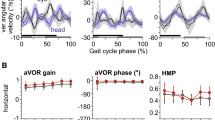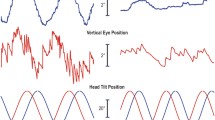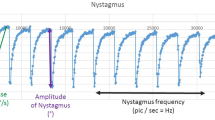Abstract
Vestibular reflexes act to stabilize the head and eyes in space during locomotion. Head stability is essential for postural control, whereas retinal image stability enhances visual acuity and may be essential for an animal to distinguish self-motion from that of an object in the environment. Guinea pig eye and head movements were measured during passive whole-body rotation in order to assess the efficacy of vestibular reflexes. The vestibulo-ocular reflex (VOR) produced compensatory eye movements with a latency of ~7 ms that compensated for 46% of head movement in the dark and only slightly more in the light (54%). Head movements, in response to abrupt body rotations, also contributed to retinal stability (21% in the dark; 25% in the light) but exhibited significant variability. Although compensatory eye velocity produced by the VOR was well correlated with head-in-space velocity, compensatory head-on-body speed and direction were variable and poorly correlated with body speed. The compensatory head movements appeared to be determined by passive biomechanical (e.g., inertial effects, initial tonus) and active mechanisms (the vestibulo-collic reflex or VCR). Chemically induced, bilateral lesions of the peripheral vestibular system abolished both compensatory head and eye movement responses.





Similar content being viewed by others
References
Andrews J, Li J, Koyama S, Hoffman L (1997) Vestibular and optokinetic function in the normal guinea pig. Ann Otol Rhinol Laryngol 106(10 Pt 1):838–847
Baker J (2005) Dynamics and directionality of the vestibulo-collic reflex (VCR) in mice. Exp Brain Res 167(1):108–113
Bamonte F, Monopoli A, Ongini E, Sabetta F, Ferraresi A, Pettorossi V (1986) Comparative actions of four aminoglycoside antibiotics on the vestibular function in guinea-pigs. Arch Int Pharmacodyn Thér 282(1):161–176
Beraneck M, Hachemaoui M, Idoux E, Ris L, Uno A, Godaux E et al (2003) Long-term plasticity of ipsilesional medial vestibular nucleus neurons after unilateral labyrinthectomy. J Neurophysiol 90(1):184–203
Bizzi E, Kalil R, Tagliasco V (1971) Eye-head coordination in monkeys: evidence for centrally patterned organization. Science 173(3995):452–454
Bui B, Vingrys A (1999) Development of receptoral responses in pigmented and albino guinea-pigs (Cavia porcellus). Doc Ophthalmol 99(2):151–170
Collewijn H (1977) Optokinetic and vestibulo-ocular reflexes in dark-reared rabbits. Exp Brain Res 27:287–300
Crane B, Demer J (1998) Human horizontal vestibulo-ocular reflex initiation: effects of acceleration, target distance, and unilateral deafferentation. J Neurophysiol 80(3):1151–1166
Cullen K, Roy J (2004) Signal processing in the vestibular system during active versus passive head movements. J Neurophysiol 91(5):1919–1933
Cullen K, Rey C, Guitton D, Galiana H (1996) The use of system identification techniques in the analysis of oculomotor burst neuron spike train dynamics. J Comp Neurosci 3(4):347–368
Curthoys I, Topple A, Halmagyi G (1995) Unilateral vestibular deafferentation (UVD) causes permanent asymmetry in the gain of the yaw VOR to high acceleration head impulses in guinea pigs. Acta Otolaryngol Suppl 520(Pt 1):59–61
Dichgans J, Bizzi E, Morasso P, Tagliasco V (1974) The role of vestibular and neck afferents during eye-head coordination in the monkey. Brain Res 71(2–3):225–232
Escudero M, Waele C, Vibert N, Berthoz A, Vidal P (1993) Saccadic eye movements and the horizontal vestibulo-ocular and vestibulo-collic reflexes in the intact guinea-pig. Exp Brain Res 97(2):254–262
Forge A, Li L (2000) Apoptotic death of hair cells in mammalian vestibular sensory epithelia. Hear Res 139(1–2):97–115
Forge A, Li L, Corwin J, Nevill G (1993) Ultrastructural evidence for hair cell regeneration in the mammalian inner ear. Science 259(5101):1616–1619
Forge A, Li L, Nevill G (1998) Hair cell recovery in the vestibular sensory epithelia of mature guinea pigs. J Comp Neurol 397(1):69–88
Freedman E (2008) Coupling between horizontal and vertical components of saccadic eye movements during constant amplitude and direction gaze shifts in the rhesus monkey. J Neurophysiol 100(6):3375–3393
Fuchs A, Robinson D (1966) A method for measuring horizontal and vertical eye movement chronically in the monkey. J Appl Physiol 21(3):1068–1070
Fuller J (1981) Eye and head movements during vestibular stimulation in the alert rabbit. Brain Res 205(2):363–381
Gdowski G, McCrea R (1999) Integration of vestibular and head movement signals in the vestibular nuclei during whole-body rotation. J Neurophysiol 82(1):436–449
Gilchrist D, Curthoys I, Cartwright A, Burgess A, Topple A, Halmagyi M (1998) High acceleration impulsive rotations reveal severe long-term deficits of the horizontal vestibulo-ocular reflex in the guinea pig. Exp Brain Res 123(3):242–254
Goldberg J, Peterson B (1986) Reflex and mechanical contributions to head stabilization in alert cats. J Neurophysiol 56(3):857–875
Graf W, de Waele C, Vidal P (1995) Functional anatomy of the head-neck movement system of quadrupedal and bipedal mammals. J Anat 186(Pt. 1):55–74
Gresty M (1975) Eye, head and body movements of the guinea pig in response to optokinetic stimulation and sinusoidal oscillation in yaw. Pflügers Arch Eur J Physiol 353(3):201–214
Horak F (2010) Postural compensation for vestibular loss and implications for rehabilitation. Restor Neurol Neurosci 28(1):57–68
Hoshowsky B, Tomlinson D, Nedzelski J (1994) The horizontal vestibulo-ocular reflex gain during active and passive high-frequency head movements. Laryngoscope 104(2):140–145
Huterer M, Cullen K (2002) Vestibuloocular reflex dynamics during high-frequency and high-acceleration rotations of the head on body in rhesus monkey. J Neurophysiol 88(1):13–28
Jones G, Balaban C, Jackson R (2003) Effect of trans-bullar gentamicin treatment on guinea pig angular and linear vestibulo-ocular reflexes. Exp Brain Res 152(3):293–306
Judge S, Richmond B, Chu F (1980) Implantation of magnetic search coils for measurement of eye position: an improved method. Vis Res 20(6):535–538
Keshner E, Peterson B (1995) Mechanisms controlling human head stabilization. I. Head-neck dynamics during random rotations in the horizontal plane. J Neurophysiol 73(6):2293–2301
Keshner E, Cromwell R, Peterson B (1995) Mechanisms controlling human head stabilization. II. Head-neck characteristics during random rotations in the vertical plane. J Neurophysiol 73(6):2302–2312
Kim A, Beyer L, King W, Raphael Y (2007) Restoration of balance sensory epithelium and function by notch signaling inhibition. Assoc Res Otolaryngol Annu Meet 1218
Kopke R, Jackson R, Li G, Rasmussen M (2001) Growth factor treatment enhances vestibular hair cell renewal and results in improved vestibular function. Proc Natl Acad Sci 98(10):5886–5891
Lue JH, Day AS, Cheng PW, Young YH (2008) Vestibular evoked myogenic potentials are heavily dependent on type I hair cell activity of the saccular macula in guinea pigs. Audiol Neurootol 14:59–66
Marlinsky V, Kröller J (2000) Optokinetic eye movements elicited by an apparently moving visual pattern in guinea pigs. Exp Brain Res 131(3):350–358
Minor L, Lasker D, Backous D, Hullar T (1999) Horizontal vestibuloocular reflex evoked by high-acceleration rotations in the squirrel monkey. I. Normal responses. J Neurophysiol 82(3):1254–1270
Peng G, Hain T, Peterson B (1996) A dynamical model for reflex activated head movements in the horizontal plane. Biol Cybern 75(4):309–319
Pettorossi V, Bamonte F, Errico P, Ongini E, Draicchio F, Sabetta F (1986) Vestibulo-ocular reflex (VOR) in guinea pigs. Impairment induced by aminoglycoside antibiotics. Acta Otolaryngol 101(5–6):378–388
Ris L, Godaux E (1998) Neuronal activity in the vestibular nuclei after contralateral or bilateral labyrinthectomy in the alert guinea pig. J Neurophysiol 80(5):2352–2366
Ris L, de Waele C, Serafin M, Vidal P, Godaux E (1995) Neuronal activity in the ipsilateral vestibular nucleus following unilateral labyrinthectomy in the alert guinea pig. J Neurophysiol 74(5):2087–2099
Ris L, Capron B, de Waele C, Vidal P, Godaux E (1997) Dissociations between behavioural recovery and restoration of vestibular activity in the unilabyrinthectomized guinea-pig. J Physiol 500(Pt 2):509–522
Robinson D (1963) A method of measuring eye movement using a scleral search coil in a magnetic field. IRE Trans Biomed Electron 10(4):137–145
Roy J, Cullen K (1998) A neural correlate for vestibulo-ocular reflex suppression during voluntary eye-head gaze shifts. Nat Neurosci 1(5):404–410
Roy J, Cullen K (2001) Selective processing of vestibular reafference during self-generated head motion. J Neurosci 21(6):2131–2142
Roy J, Cullen K (2002) Vestibuloocular reflex signal modulation during voluntary and passive head movements. J Neurophysiol 87(5):2337–2357
Serafin M, Ris L, Bernard P, Muhlethaler M, Godaux E, Vidal PP (1999) Neuronal correlates of vestibulo-ocular reflex adaptation in the alert guinea-pig. Eur J Neurosci 11(5):1827–1830
Sha S, Schacht J (2000) Antioxidants attenuate gentamicin-induced free radical formation in vitro and ototoxicity in vivo: D-methionine is a potential protectant. Hear Res 142(1–2):34–40
Shanidze N, Kim AH, Loewenstein S, Raphael Y, King WM (2010) Eye-head coordination in the guinea pig II. Responses to self-generated (voluntary) head movements. Exp Brain Res. doi: 10.1007/s00221-010-2375-3
Snyder L, King W (1992) Effect of viewing distance and location of the axis of head rotation on the monkey’s vestibuloocular reflex. I. Eye movement responses. J Neurophysiol 67(4):861–874
Song B, Anderson D, Schacht J (1997) Protection from gentamicin ototoxicity by iron chelators in guinea pig in vivo. J Pharmacol Exp Ther 282(1):369–377
Stahl J, van Alphen A, de Zeeuw C (2000) A comparison of video and magnetic search coil recordings of mouse eye movements. J Neurosci Method 99(1–2):101–110
Takemura K, King W (2005) Vestibulo-collic reflex (VCR) in mice. Exp Brain Res 167(1):103–107
Tweed D, Glenn B, Vilis T (1995) Eye-head coordination during large gaze shifts. J Neurophysiol 73(2):766–779
Vibert N, de Waele C, Escudero M, Vidal P (1993) The horizontal vestibulo-ocular reflex in the hemilabyrinthectomized guinea-pig. Exp Brain Res 97(2):263–273
Vingrys A, Bui B (2001) Development of postreceptoral function in pigmented and albino guinea pigs. Vis Neurosci 18(4):605–613
Walsh R, Hackney C, Furness D (2000) Regeneration of the mammalian vestibular sensory epithelium following gentamicin-induced damage. J Otolaryngol 29(6):351–360
Yamane H, Nakagawa T, Iguchi H, Shibata S, Takayama M, Nishimura K et al (1995) In vivo regeneration of vestibular hair cells of guinea pig. Acta Otolaryngol Suppl 520(Pt 1):174–177
Yang T-H, Young Y-H (2005) Click-evoked myogenic potentials recorded on alert guinea pigs. Hear Res 205(1–2):277–283
Zhou W, Weldon P, Tang B, King W (2003) Rapid motor learning in the translational vestibulo-ocular reflex. J Neurosci 23(10):4288–4298
Acknowledgments
We want to acknowledge the contribution of Keiji Takemura, M.D. who helped us develop the methodology for testing guinea pigs; Kevin Lim for his programming expertise; Scott Loewenstein who collected some of the data reported here; Beth Hand and James Liadis for data collection and animal care and handling. Dwayne Valliencourt designed and built the specialized animal restraints and Chris Ellinger kept our electronics running. This research was supported by National Institutes of Health grants: P30 NDC005188-07, R21-DC008607-01, and T32 DC000011–30.
Author information
Authors and Affiliations
Corresponding author
Rights and permissions
About this article
Cite this article
Shanidze, N., Kim, A.H., Raphael, Y. et al. Eye–head coordination in the guinea pig I. Responses to passive whole-body rotations. Exp Brain Res 205, 395–404 (2010). https://doi.org/10.1007/s00221-010-2374-4
Received:
Accepted:
Published:
Issue Date:
DOI: https://doi.org/10.1007/s00221-010-2374-4




